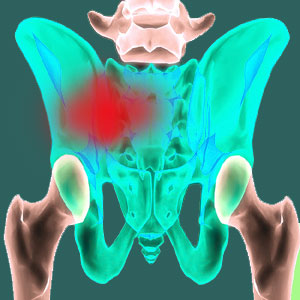
Are you searching for a sacroiliac pain explanation which makes sense? We can help. Sacroiliac pain does not have to be difficult to understand. In fact, we encourage all patients to thoroughly comprehend all aspects of their diagnosis, including why they have pain and what can be done to cure the problem.
So many readers write to us saying that they are confused by the information they received from their doctor. Many also write about how much of the information on the internet is beyond their ability to understand, being written for a professional medical audience. These are the people who ask us for a simple explanation of what exactly sacroiliac joint pain is, what causes it and what can be done to resolve it.
This essay explores a common sense view of sacroiliac pain in simple, easy to understand language. If you are looking to develop a basic understanding of the sacroiliac joint and painful conditions that can affect it, this is a great place to begin your search.
Sacroiliac Pain Explanation of Joint Anatomy
The sacroiliac joint, also known as the SIJ, is the area of the body where the pelvis meets the spine. The name comes from the 2 joining structures, which are the spinal region known as the sacrum (sacro) and the pelvic “butterfly” known as the ilium (iliac). Add these 2 structures together and where they meet, you have the sacroiliac joint.
The sacroiliac is a very important joint, since it connects the legs to the spine and helps manage the various tasks that involve both the lower limbs and the torso. The joint is incredibly strong and durable. The SIJ does not move much in adults, but does have a limited range of motion which can be evaluated using a variety of anatomical testing procedures
The sacroiliac joint is not only composed of the bony structures of the sacrum and the pelvic ilium. It is also bonded by soft tissues that keep the joint strong and regulate movement of the SIJ when necessary.
SIJ Pain Causes Explained
Injury to the sacroiliac is rare, but can occur and might affect many structures that compose the joint. It is easy to understand how trauma can damage the joint, in much the same manner that injury can affect any other region of the human body.
Inflammation in the joint can be caused by trauma, disease and infection, as well as from other possible sources. Sacroiliac joint inflammation is usually called sacroiliitis.
A painful sacroiliac joint might result from a variety of possible factors. As we age and use our bodies, the sacroiliac joint, like most structures in the human anatomy, will demonstrate changes that are known as degeneration. This degeneration describes general wear and deterioration of the perfect state of the tissue. Degeneration in the sacroiliac joint is normal, expected and universally experienced by all adult humans to one degree or another. However, some people experience more degeneration than others and might experience pain due to this aging of the joint. Generally the mechanisms for pain in these cases is arthritis, which describes skeletal and joint changes common to aging that might become painful in select circumstances.
There might also be problems that affect the soft tissues that bond and regulate the joint in its range of motion. These tissues are called ligaments and are usually tight enough to prevent too much movement within the joint, and loose enough to allow the right amount of movement when motion is indeed necessary. In essence, the ligaments of the sacroiliac joint determine how and how much the joint moves when required. These soft connecting tissues can also suffer injury or degeneration which might make them too loose or too tight. When the sacroiliac is too loose, it is called hyperlaxity and might make the joint move more than is considered normal, possibly making the joint become unstable and painful. Too much movement in the SIJ is called sacroiliac tightness, or hypomobility, and describes a fundamental inability for the joint to move when needed. This condition might also be painful in some instances.
Sacroiliac Pain Explanation of Treatment
Treatment recommendations for sacroiliac pain are determined by diagnostic evaluation to determine the cause of pain and the best way to stop it. Usually, SIJ treatment is nonsurgical in nature, consisting of drug therapies, injections, physical therapy and exercise recommendations. Most diagnoses and most patients will be able to achieve positive treatment results from these types of care as long as the diagnosis is correct. In rare cases, surgery might be performed to fuse the sacroiliac joint and prevent it from moving ever again to any extent at all.
Most sacroiliac pain problems can be resolved without surgery, so we tend to caution patients to attempt all varieties of conservative care before considering undergoing an operation. Similarly, there are good and bad forms of conservative care and we tend to advise using practices that are natural and constructive to general health, such as exercise, stretches, chiropractic, massage, TENS, physical therapy, while avoiding dangerous drug therapies, using oral or injectable poisons. There is little benefit to relieving sacroiliac joint pain just to suffer some other negative health issue due to the drugs often utilized during treatment.
Sacroiliac Joint Pain > Sacroiliac Facts > Sacroiliac Pain Explanation





